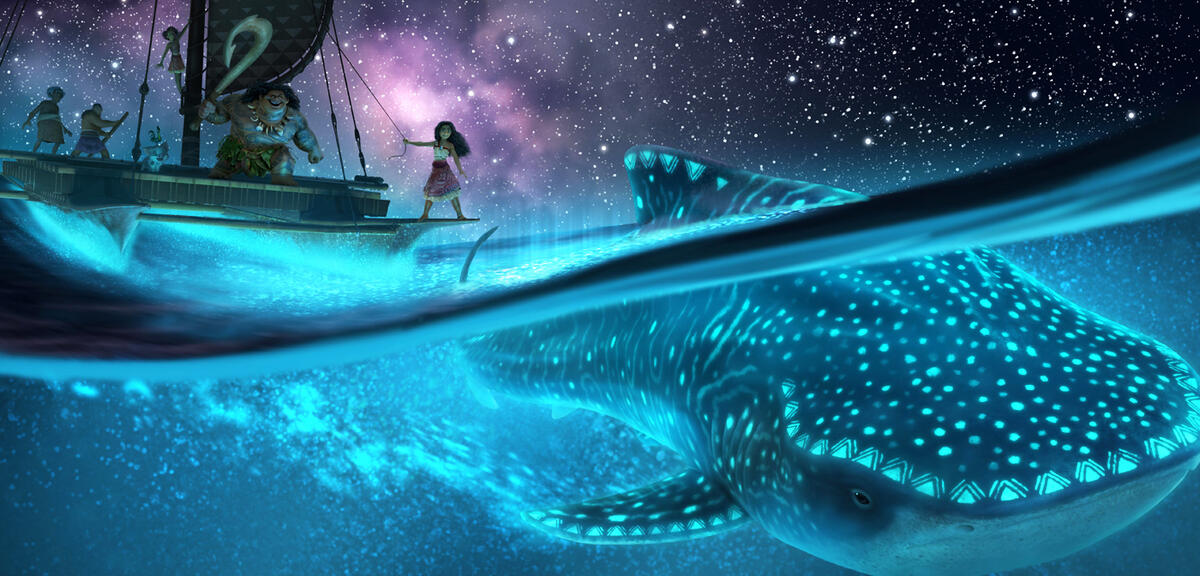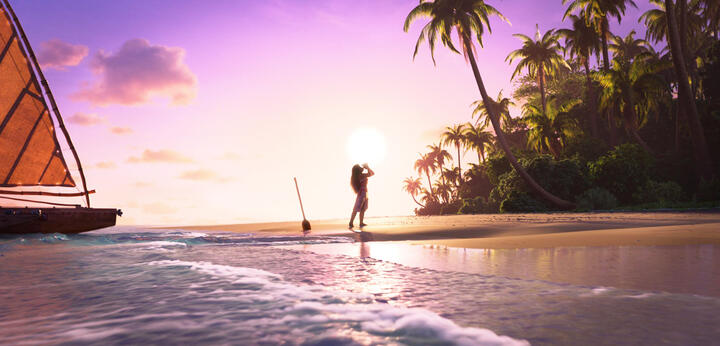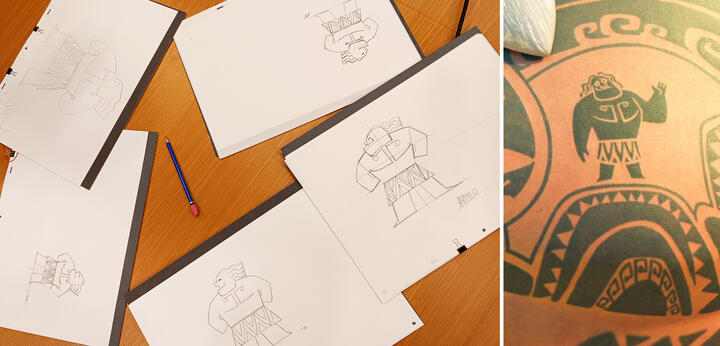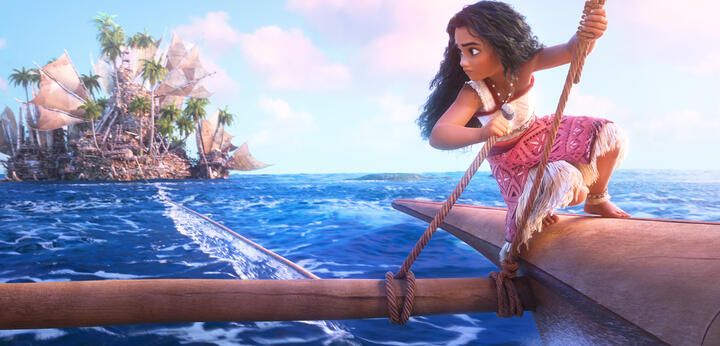How does an animated film come to life at Disney these days? During a visit to the famous studio, the creative minds behind Vaiana 2 gave amazing insights. The days when Disney’s animated films were laboriously hand-drawn frame by frame are long gone. Today, the imaginative adventure stories are mainly created on the computer and put together from countless digital animations. That sounds abstract and complicated. But once you know what goes into the process, it’s just as impressive as the traditional approach to an animated film.
To find out, I had to cross an ocean. A month before the theatrical release of Vaiana 2, I visited the Disney Animation Studios as a guest of Moviepilot. At the Burbank site, north of Los Angeles, studio employees and creatives gave me an insight into their processes. It’s hard to imagine all the effort that goes into it from the comfort of your movie theater seat. So I’ll take you by the hand and tell you how a modern animated film is born – if you’re willing to walk these 6 steps to the finished movie with me.
1. The initial idea for a new Disney movie is born
Like so many things, a Disney animated film begins with a small step, the sprout of an idea that grows over months and years into a sprawling cinematic giant. No wonder that animated films often have more than one directing talent holding the reins. There are three for Moana 2: David G. Derrick Jr., Dana Ledoux Miller and Jason Hand. Although they have been in the animation film business for quite some time (Hand and Derrick were previously animators themselves, for example), this is the first time they have taken a seat in the director’s chair. They are the gardeners who, according to the script team (Jared Bush and Dana Miller), ensure that the film grows and thrives.
In the case of Vaiana, this included two research trips to Polynesian islands and trying out old types of boats, as well as discussions about the story and characters. Fans complained after part 1 that the pig Pua was not allowed on the sea voyage? No problem, in part 2 it comes with them on the new ocean trip. Some time has passed since the events of the first movie? This naturally suggests new potential for development for the now older heroine. The fact that the sequel was originally conceived as a Disney+ series certainly did not make the eight years during which it then took shape as a film any less complicated.
For stories with ethnic peculiarities such as a heroine from Oceania, informed cultural advisors are important. That’s why two of the three directors, Derrick and Miller, are of Polynesian descent themselves. In addition, the Oceanic Cultural Trust was set up after Vaiana so that linguists, historians, anthropologists, choreographers and many more clever people could provide valuable input.
2. Character paintings are drawn before animation
Of course, Vaiana 2 brings back many characters that the audience has known for a long time. Nevertheless, these characters need to be developed further. In addition, new characters join the sequel, which require intensive planning: What characterizes Vaiana’s new crew members Loto, Kele and Moni? How does her new little sister Simea define herself? Based on sketches, a fully-fledged character image is gradually created for each of them.
Amy Smeed, head animator for Moana 2, explains that the pre-production team initially only exists on a small scale. So-called “rigs”, or character frameworks, are created on the computer to bring the figures to life at the simplest level, using ongoing skeletal tests, movements and body shapes: The “riggers” (early animators) create 6-minute moving computer paintings in which the characters walk, scratch their noses and more.
Storyboards also play an indispensable role here: like a large-format comic, they tell the story in pictures. That’s because sophisticated computer animation is expensive and time-consuming, and when weeks of work go into a few seconds of the finished film, you don’t want to have to cut out a laboriously animated scene later on. Drew, the guide at Disney’s sprawling studio lot, proudly explains that Disney even came up with storyboards before many other film companies adapted them for their live-action films to save time and money. (According to Make Storyboard, the Disney short film The Three Little Pigs was the first to be made using this principle in 1933.)
3. The voices are recorded without animation
In Germany, animated films are dubbed as soon as the film (on the image level) is finished. In the US, the voice actors are recorded before the animation. “After all, a sentence on paper can be pronounced in countless ways,” explains Smeed. The animators need to know how the words will be interpreted before they create the appropriate facial expressions on the computer.
While the stars who speak are sometimes guided by storyboards, they are in turn filmed while they speak their lines in the dubbing booth. This way, the computer artists can later view their faces as a reference for the character animation. In this way, they sometimes adopt the stars’ idiosyncrasies, such as Dwayne Johnson’s raised eyebrow for Maui in Moana.
However, an animated story is rarely set in stone: even after animation has begun, the story is still subject to change. This means that the actors don’t record all of their lines at once, but keep returning to Disney for audio recordings.
In addition, the soundtrack is also being created and the new songs have to be recorded. The stars’ last visit to the recording studio is at the very end for “ADR” (Automatic Dialogue Recording or Replacement). This is the classic post-synchronization process in which new or modified passages are recorded bit by bit with exact lip movement. This is the final fine-tuning when the animation is completely finished.
4. The actual animation of a Disney film takes a long time.
The actual animation work only begins after the general ideas and voice recordings have been approved: 140 animators worked on Moana 2, Amy Smeed reveals, and a total of 850 people are part of the crew.
Tyler, a Disney animator who looks as young as a high school student, teaches me how to draw Mini-Maui on a piece of paper – Mini-Maui being the demigod of Maui’s living tattoo conscience, a bit like Jimminy Cricket in Pinocchio. Even though the creation process has changed dramatically over the past few decades, moving from paper to digital, there are still three animation steps to creating the characters:
a) “Rough Animation” (the rough drawing/animation)
b) “Ink and Paint” (the process of refining the lines that are actually needed)
c) “Final CG Animation” (the final computer animation).
Different artists are assigned different scenes and animation elements in Disney films, which in turn are coordinated by the head animators. So-called “dailies”, i.e. raw daily results, are shown to the directors in a screening room after initial progress has been made. The directors then either accept the results or send them back to the creatives with notes for revision. Creating animated water and hair that looks believable has always been one of the biggest challenges. However, there have been enormous technical advances in recent years to make liquids and hairstyles look more convincing. Even with landscapes, the animators themselves are sometimes amazed that they can hardly distinguish fiction from reality in the image.
Head animator Amy Smeed is keen to emphasize that Disney relies on the work of creatives rather than artificial intelligence for the animation process. This goes so far that the computer artists also repeatedly film their own families in order to correctly depict motion sequences. “How does a toddler open their hands to show you a shell in them? Ask your daughter, she’ll show you.” This means that private moments can be smuggled into a Disney blockbuster. When Smeed watches the princess scene in Ralph Breaks the Internet, for example, she is always smiling as she remembers her own daughter, who was the inspiration for this.
5. Animation film sounds add the finishing touches
Special employees who are only brought in towards the end of the animation process are the so-called Foley artists, or foley artists. In Disney’s Vaiana 2, Ronni Brown is in charge of the soundscape. The sound designer belongs to the company Skywalker Sound, has already recorded Darth Vader’s boot noises and is now faced with the task of inventing convincing sounds for an animated film.
This involves experimenting and listening: a special fish in Vaiana 2, for example, creeps into the ear with smacking suction cup noises on a leather cloth soaked in hair gel. Heihei’s chicken foot scraping on board a wooden boat, on the other hand, is created with dried flowers.
What Brown likes about working on an animated film is that she can be more daring than when dubbing live-action films. Everything can be a bit over the top to emphasize the comedic effect. That’s why she can add a squeaking sound that doesn’t exist in reality when the main character crashes into a few leaves. Her job is a “marriage of art and science,” the foley artist explains. She has the database of possible sounds mostly in her head, but when an unusual sound pops up in her daily life, she wants to save it. But Brown’s prop warehouse is also full of curious utensils that she collects in order to elicit useful sounds from them at some point.
6. The finished Disney animated film is finally coming to the cinema
Of course, all these creative processes don’t just happen in an orderly fashion, one after the other; they also intertwine until a finished whole emerges thanks to the precise coordination of the directing team. The Moana 2 trio revealed during my visit to LA that they had only finished their film a week ago – just under 6 weeks before its theatrical release.
It’s impressive that the years of work on such a large-scale project can be calculated so precisely (the theatrical release of Vaiana 2 was announced this February). Just as impressive is the effort that hundreds of hands put into the creation of such an animated film.





